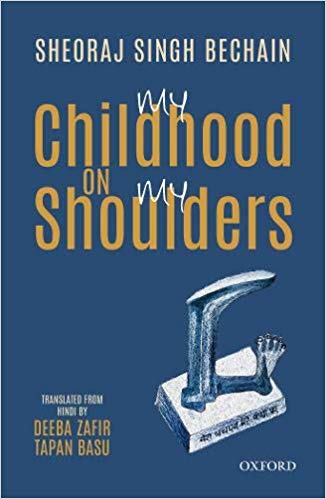Sheoraj Singh ‘Bechain’, currently Professor in the Department of Hindi, University of Delhi, was born in a family of Chamars in Nadrauli, in the Badaun district of Uttar Pradesh. He cleared his matriculation in 1978 at the age of 18, with extraordinary resilience, courage and determination, surmounting a heart-breaking period of social isolation, family alienation, extreme physical hardship, hunger and poverty. Mera Bachpan Mere Kandhon Par, his autobiography documenting the early 10-year period of his struggle to live and educate himself (up to matriculation), was published in 2009 and has already been translated into Punjabi and Urdu. Thanks to the initiative of the Translation Editor of OUP, Mini Krishnan, who spotted a translated excerpt of Bechain’s writing in Tehelka even before the Hindi original was published, we now have the English version, although it took nearly a decade to see the light of day. The painstaking translation by Deeba Zafir and Tapan Basu appears to have overcome the challenge of rendering the curious admixture of khaddar boli (a dialect spoken in the areas surrounding Badaun) and Hindi quite successfully as the English text reads seamlessly without flagging reader interest in even a single page.
In 1979, just a year around the time after Bechain cleared matriculation, India and the world took notice of Loksen Lalvani’s famed 16-minute documentary for Films Division titled ‘They Call Me Chamar’ which narrated how Ramdayal Dixit, a Brahmin became Ramdayal Chamar after his marriage to Rajkumari, a Harijan. The location was Dhakva, 30 kms from Varanasi. We are shown vultures in the background, cattle being skinned and a naked child barely three or four years old, toying with a portion of the animal skeleton which remained after skinning. Ramdayal living with the Chamars after his ex-communication carries on unfazed. The Chamars even make him a mukhiya. Bechain’s first person account however travels far beyond: it is Orwellian in its delivery, full of the immediacy of personal experiences.
Bechain’s early life story set in Nadrauli, Pali Mukimpur, Chandausi, Chirori, Kesar Kalan, Kasra, Dibai, Baajpur, Raipur, Gunnaur and Delhi (Rajouri Garden), and originally written in 2009, nearly two decades after Lalvani’s film, drives home the point forcefully to the reader that things have probably gotten worse if not pretty much the same even after several decades of Independence and despite all the relief schemes and so called affirmative action programmes announced from time to time in the name of Dalit emancipation. What stands out in the book is also the story of a certain section of Chamars who called themselves Jatavs after giving up leatherwork and who discriminated against their own fellow caste members in the most vicious manner possible.

